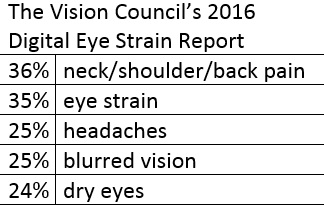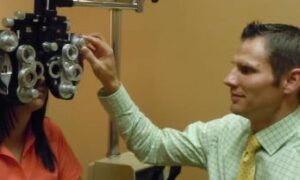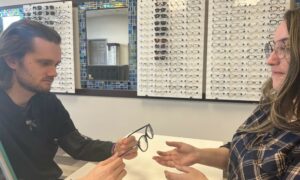
Jan. 20, 2016
You have an opportunity to serve patients experiencing digital eye strain, findings from The Vision Council’s 2016 Digital Eye Strain Report suggest. Sixty-five percent of Americans report experiencing symptoms of digital eye strain, according to the study. Thirty-six percent report experiencing neck/shoulder/back pain, while 35 percent say they experience eye strain. Twenty-five percent say they experience headaches, while another 25 percent report blurred vision, and 24 percent say they experience dry eyes.
Did you know that nearly 90 percent of Americans use digital devices for two or more hours per day? Or that nearly 60 percent of Americans use digital devices for five or more hours per day? The Vision Council’s 2016 Digital Eye Strain Report tells us that 65 percent of people report digital eye strain. Another number you should know is that 77 percent of people suffering from digital eye strain use two or more devices simultaneously.
This chart gives a breakdown of the symptoms people reported.

Eyestrain, headaches, blurred vision and dry eyes … those are all conditions that we treat. Yet many of our patients don’t conclude that there could be a visual problem that needs addressed. We need to help them connect the dots and then make sure it is easy for them to get their treatment from us.
Here’s your Action Plan for this week.
1) Evaluate your pre-examination history questionnaire to make sure you are asking at least …
a. These two questions about digital devices:
i. How many hours each day do you use digital devices?
ii. Do you ever use two or more devices simultaneously?
b. If the patient ever experiences …
i. Neck/shoulder/back pain
ii. Eyestrain
iii. Headaches
iv. Blurred vision
v. Dry eyes
2) Evaluate your case presentation for patients experiencing symptoms related to digital device use.
a. Always relate your examination findings back to the patient history. As much as possible, use the patient’s exact words in your case presentation (“Mr. Smith, when you came in today you told me ‘… my eyes feel strained after working on my computer for a couple of hours … ‘ “).
b. Link your exam findings to the history (“My examination shows a weakness in your visual system that contributes to that eye strain you are experiencing when you work on your computer for a couple of hours.”).
c. Prescribe a solution. (“Mr. Smith, I am going to prescribe glasses for you to wear when you work on your computer that will help alleviate the eye strain you’ve been experiencing. I’m prescribing the power for these lenses, and also the lens design and the manufacturing process. My optician will help you with frame selection and will explain my prescription for exactly how I want you to use these lenses.”)
3) Measure your effectiveness. If you prescribe it, does the patient get it in your practice? Look at the Practice Analysis Report from your lab to compare your number of computer glasses sold to the reported national and local benchmarks. Put in place systems to make your practice more effective in capturing patients in your practice rather than having them not fill the prescription, or worse yet, fill the prescription somewhere other than your practice.
If you prescribed treatment other than glasses, it is important the patient fills that prescription, as well. If your case presentation gave the patient a treatment for dry eyes, did you send them on a scavenger hunt (i.e.: “Get these lid wipes at the pharmacy and these eye drops at the grocery store”) or have you created an easy system for the patient to get everything they need in your practice? To do this, create Mild, Moderate, and Severe Dry Eye Packages that patients can purchase from you. To increase compliance with your treatment plan, prescribe it in the exam room and help the patient leave the office today with the appropriate Dry Eye Package.
Make it easy for the patient to do business in your practice and you will find your effectiveness will increase. This is good for the patient and good for the practice.

























